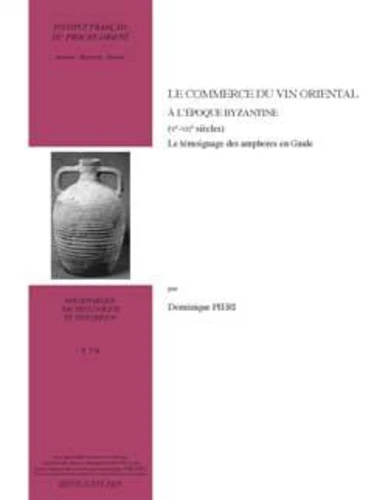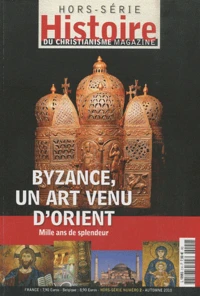Le commerce du vin oriental à l'époque byzantine (Ve-VIIe siècles). Le témoignage des amphores en Gaule
Par :Formats :
Disponible dans votre compte client Decitre ou Furet du Nord dès validation de votre commande. Le format Multi-format est :
- Pour les liseuses autres que Vivlio, vous devez utiliser le logiciel Adobe Digital Edition. Non compatible avec la lecture sur les liseuses Kindle, Remarkable et Sony
 , qui est-ce ?
, qui est-ce ?Notre partenaire de plateforme de lecture numérique où vous retrouverez l'ensemble de vos ebooks gratuitement
Pour en savoir plus sur nos ebooks, consultez notre aide en ligne ici
- Nombre de pages329
- FormatMulti-format
- ISBN2-35159-293-X
- EAN9782351592939
- Date de parution01/01/2005
- Protection num.NC
- Infos supplémentairesMulti-format incluant PDF avec W...
- ÉditeurIFPO
Résumé
À partir d'un recensement des amphores de provenance orientale découvertes en Gaule sur une centaine de sites de l'Antiquité tardive, cette recherche aborde un des aspects de l'histoire économique antique, à travers l'étude des échanges commerciaux entre l'Orient et l'Occident, relatifs aux biens transportés en amphores. La connaissance, jusqu'alors lacunaire, des amphores de cette période a imposé une étude céramologique approfondie afin de mettre en place une typologie précise, qui se veut un instrument de datation supplémentaire pour l'archéologue.
L'épigraphie ainsi que l'étude des pâtes font partie des outils qui ont menéà l'établissement de la provenance et du contenu des formes préalablement définies. La diffusion de ces amphores en Gaule et dans le monde méditerranéen nous éclaire sur l'orientation des circuits commerciaux et des échanges, de même que l'analyse des régions d'approvisionnement permet d'observer des fluctuations aussi bien historiques que géographiques de ces sources.
À partir des éléments matériels recueillis, il est ainsi devenu possible d'apporter une contribution à la compréhension de l'économie de l'Antiquité tardive, en cette période charnière qui a vu le passage du monde antique au monde médiéval. Based on an inventory of the amphoras of Eastern origin discovered in Gaule from a hundred of archaeological sites of Late Antiquity, this research tackles some aspects of ancient economic history, through the study of the trade of goods transported in amphoras between the East and the West.
Knowledge, hitherto incomplete, of the amphoras of this period required a more thorough ceramic study in order to establish an accurate typology, which is intended to be an additional aid for dating by archaeologists. Epigraphy as well as the study of the fabrics, are the tools which are means of establishing the origin and the contents of the amphoras. Their diffusion in Gaule and in the Mediterranean world informs us about the commercial trade and exchange routes, and the analysis of the supply areas makes it possible to observe historical as well as geographical fluctuations.
Starting from the material elements thus collected, it is possible to contribute to the understanding of the economy of Late Antiquity, at this transitional turning point period which witnessed the progression from the ancient to the medieval world.
L'épigraphie ainsi que l'étude des pâtes font partie des outils qui ont menéà l'établissement de la provenance et du contenu des formes préalablement définies. La diffusion de ces amphores en Gaule et dans le monde méditerranéen nous éclaire sur l'orientation des circuits commerciaux et des échanges, de même que l'analyse des régions d'approvisionnement permet d'observer des fluctuations aussi bien historiques que géographiques de ces sources.
À partir des éléments matériels recueillis, il est ainsi devenu possible d'apporter une contribution à la compréhension de l'économie de l'Antiquité tardive, en cette période charnière qui a vu le passage du monde antique au monde médiéval. Based on an inventory of the amphoras of Eastern origin discovered in Gaule from a hundred of archaeological sites of Late Antiquity, this research tackles some aspects of ancient economic history, through the study of the trade of goods transported in amphoras between the East and the West.
Knowledge, hitherto incomplete, of the amphoras of this period required a more thorough ceramic study in order to establish an accurate typology, which is intended to be an additional aid for dating by archaeologists. Epigraphy as well as the study of the fabrics, are the tools which are means of establishing the origin and the contents of the amphoras. Their diffusion in Gaule and in the Mediterranean world informs us about the commercial trade and exchange routes, and the analysis of the supply areas makes it possible to observe historical as well as geographical fluctuations.
Starting from the material elements thus collected, it is possible to contribute to the understanding of the economy of Late Antiquity, at this transitional turning point period which witnessed the progression from the ancient to the medieval world.
À partir d'un recensement des amphores de provenance orientale découvertes en Gaule sur une centaine de sites de l'Antiquité tardive, cette recherche aborde un des aspects de l'histoire économique antique, à travers l'étude des échanges commerciaux entre l'Orient et l'Occident, relatifs aux biens transportés en amphores. La connaissance, jusqu'alors lacunaire, des amphores de cette période a imposé une étude céramologique approfondie afin de mettre en place une typologie précise, qui se veut un instrument de datation supplémentaire pour l'archéologue.
L'épigraphie ainsi que l'étude des pâtes font partie des outils qui ont menéà l'établissement de la provenance et du contenu des formes préalablement définies. La diffusion de ces amphores en Gaule et dans le monde méditerranéen nous éclaire sur l'orientation des circuits commerciaux et des échanges, de même que l'analyse des régions d'approvisionnement permet d'observer des fluctuations aussi bien historiques que géographiques de ces sources.
À partir des éléments matériels recueillis, il est ainsi devenu possible d'apporter une contribution à la compréhension de l'économie de l'Antiquité tardive, en cette période charnière qui a vu le passage du monde antique au monde médiéval. Based on an inventory of the amphoras of Eastern origin discovered in Gaule from a hundred of archaeological sites of Late Antiquity, this research tackles some aspects of ancient economic history, through the study of the trade of goods transported in amphoras between the East and the West.
Knowledge, hitherto incomplete, of the amphoras of this period required a more thorough ceramic study in order to establish an accurate typology, which is intended to be an additional aid for dating by archaeologists. Epigraphy as well as the study of the fabrics, are the tools which are means of establishing the origin and the contents of the amphoras. Their diffusion in Gaule and in the Mediterranean world informs us about the commercial trade and exchange routes, and the analysis of the supply areas makes it possible to observe historical as well as geographical fluctuations.
Starting from the material elements thus collected, it is possible to contribute to the understanding of the economy of Late Antiquity, at this transitional turning point period which witnessed the progression from the ancient to the medieval world.
L'épigraphie ainsi que l'étude des pâtes font partie des outils qui ont menéà l'établissement de la provenance et du contenu des formes préalablement définies. La diffusion de ces amphores en Gaule et dans le monde méditerranéen nous éclaire sur l'orientation des circuits commerciaux et des échanges, de même que l'analyse des régions d'approvisionnement permet d'observer des fluctuations aussi bien historiques que géographiques de ces sources.
À partir des éléments matériels recueillis, il est ainsi devenu possible d'apporter une contribution à la compréhension de l'économie de l'Antiquité tardive, en cette période charnière qui a vu le passage du monde antique au monde médiéval. Based on an inventory of the amphoras of Eastern origin discovered in Gaule from a hundred of archaeological sites of Late Antiquity, this research tackles some aspects of ancient economic history, through the study of the trade of goods transported in amphoras between the East and the West.
Knowledge, hitherto incomplete, of the amphoras of this period required a more thorough ceramic study in order to establish an accurate typology, which is intended to be an additional aid for dating by archaeologists. Epigraphy as well as the study of the fabrics, are the tools which are means of establishing the origin and the contents of the amphoras. Their diffusion in Gaule and in the Mediterranean world informs us about the commercial trade and exchange routes, and the analysis of the supply areas makes it possible to observe historical as well as geographical fluctuations.
Starting from the material elements thus collected, it is possible to contribute to the understanding of the economy of Late Antiquity, at this transitional turning point period which witnessed the progression from the ancient to the medieval world.





